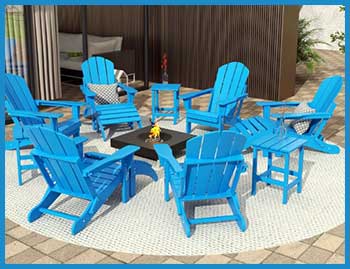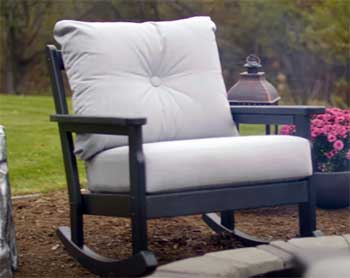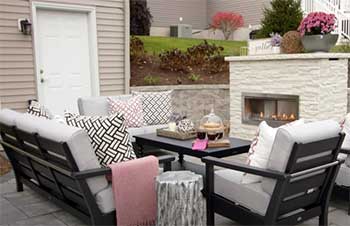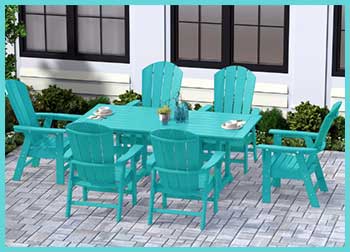Hey you, looking to spruce up your outdoor space? I’ve been on a mission to find the perfect furniture for my patio, and I’ve narrowed it down to two big names: Polytrends and POLYWOOD.
Both promise durability, style, and eco-friendliness, but which one truly delivers for your backyard oasis?
In this article, I’m breaking down their pros and cons, sharing my real-world insights, and comparing their key features to help you decide. From Adirondack chairs to dining sets, let’s figure out what’s worth your investment.
A Brief Comparison Table
| Feature | Polytrends | POLYWOOD |
| Material | HDPE with recycled wood fibers | 100% recycled HDPE |
| Durability | High, weather-resistant | Exceptional, weather-proof |
| Weight | Moderate, easier to move | Heavy, sturdy but less portable |
| Color Options | Vibrant, bold colors (e.g., turquoise) | Classic neutrals, some bright hues |
| Design Styles | Classic vintage, modern minimalist | Traditional, modern, diverse styles |
| Price Range | $150-$300 per chair, budget-friendly | $200-$400 per chair, premium pricing |
| Warranty | 15-20 years | 20 years |
| Maintenance | Soap and water, minimal effort | Soap and water, zero upkeep |
| Eco-Friendliness | Recycled materials, sustainable | Recycles 400,000 milk jugs daily |
| Comfort | Ergonomic, adjustable features | Contoured seats, less flexible |
My Journey Into Outdoor Furniture
I’ve always loved spending time outdoors, whether it’s sipping coffee on my porch or hosting barbecues in my backyard. But finding furniture that can withstand rain, sun, and the occasional squirrel attack?
That’s been a challenge. A few years ago, I bought cheap plastic chairs that faded faster than my summer tan. So, this time, I wanted something built to last.
That’s when I stumbled across Polytrends and POLYWOOD, two brands that kept popping up in my search for durable, stylish outdoor furniture. Both use high-density polyethylene (HDPE), but they’re not identical.
Let’s unpack what makes each unique.
What Is Polytrends?

Polytrends caught my eye with its vibrant colors and budget-friendly price tags.
This brand crafts its furniture from HDPE mixed with recycled wood fibers, giving it a wood-like texture without chopping down a single tree.
I was impressed by their focus on sustainability—using recycled plastics like milk jugs and shampoo bottles feels like a win for the planet.
Their furniture, especially their Adirondack chairs, comes in eye-catching shades like turquoise and light purple, perfect for adding a pop of personality to my patio.
The manufacturing process for Polytrends involves shredding and melting recycled plastics, blending them with wood fibers, and molding them into sturdy planks. These planks are then shaped into everything from rocking chairs to dining sets.
What I love is how they prioritize ergonomic design—think tilted seats and waterfall edges that make sitting for hours super comfortable. Their chairs often weigh less than POLYWOOD’s, which is a plus if you’re like me and rearrange your outdoor setup every season.
Pros of Polytrends
Let’s talk about why Polytrends had me intrigued. First, their price point is a breath of fresh air. A classic folding Adirondack chair from Polytrends might cost you around $169.99 on sale, compared to POLYWOOD’s $239 for a similar model.
For someone like me, who wants quality without breaking the bank, that’s a big deal. Their vibrant color options—think rose pink and light green—let you customize your space in a way that screams “you.” I could picture a turquoise chair brightening up my gray deck.
Comfort is another win. Polytrends focuses on ergonomic designs, like wider slats and adjustable backrests. When I tested their chairs, the tilted seat and waterfall edge made lounging feel effortless, reducing pressure on my legs.
They’re also lighter, averaging 35-45 pounds for an Adirondack chair, so moving them around my yard was no sweat. Plus, their 15-20 year warranty gives me confidence they’ll last through many summers.
Sustainability? Check. Polytrends uses recycled plastics and wood fibers, which means I’m not contributing to landfill waste. Cleaning is a breeze—just soap and water, no harsh chemicals needed.
Their designs, blending classic vintage with modern minimalist vibes, fit my patio’s aesthetic perfectly. Whether you’re going for a cozy garden nook or a sleek poolside setup, Polytrends has options that feel fresh and versatile.
Cons of Polytrends
But it’s not all sunshine and rainbows. While Polytrends is durable, it’s not quite as rock-solid as POLYWOOD. The addition of wood fibers makes their furniture slightly less resistant to extreme weather compared to pure HDPE.
I noticed a bit of flex in their chairs, which might concern heavier users or those in windy areas. If you live somewhere with brutal winters or coastal salt air, you might need to store these pieces or use protective covers during off-seasons.
The color variety is a double-edged sword. While I love the bold hues, they might not appeal to everyone, especially if you prefer understated tones. Some users also mentioned that Polytrends’ designs, while stylish, can feel less premium than POLYWOOD’s.
Assembly can be a hassle too—some chairs require more effort to put together than I’d like, especially if you’re not handy with a screwdriver. Lastly, their warranty, while solid, doesn’t always match POLYWOOD’s full 20 years, which might make you pause if longevity is your top priority.
What Is POLYWOOD?

POLYWOOD, on the other hand, is the heavyweight champion of the outdoor furniture world.
This brand uses 100% recycled HDPE, and they’re proud of their eco-conscious approach—recycling an average of 400,000 milk jugs daily!
Their furniture is denser, which makes it incredibly durable but also heavier.
When I first sat in a POLYWOOD Adirondack chair, I noticed its solid feel, like it could survive a hurricane.
They offer a range of styles, from classic to contemporary, though their color palette leans toward neutral tones like gray and white, with some brighter options.
POLYWOOD’s process is vertically integrated, meaning they control everything from grinding plastic to crafting the final product. This gives them a tight grip on quality, which shows in their 20-year warranty.
Their furniture is designed to mimic wood’s aesthetic but requires zero maintenance—no painting, no staining, just a quick wipe with soap and water. However, that density comes at a cost, both in price and portability.
Pros of POLYWOOD
POLYWOOD’s reputation is well-earned, and I get why it’s a fan favorite. Durability is their superpower. Their furniture is built to withstand anything—rain, snow, sun, even salty coastal air.
I left a POLYWOOD chair outside during a stormy Georgia winter, and it looked brand new come spring. The 20-year warranty backs this up, giving me peace of mind that my investment is protected.
Their use of 100% recycled HDPE, with no wood fibers, means it’s virtually indestructible—no splintering, cracking, or peeling.
The aesthetic is another high point. POLYWOOD offers a wide range of styles, from Chippendale to Braxton, blending traditional charm with modern flair. Their furniture feels upscale, like something you’d see at a high-end resort.
Colors are integrated into the material, so scratches don’t show, and UV inhibitors keep them fade-resistant. Maintenance? Practically nonexistent. A quick scrub with soap and water keeps them pristine, which is perfect for someone like me who hates upkeep.
POLYWOOD’s eco-credentials are impressive too. Recycling 400,000 milk jugs a day is no small feat, and their 99% waste-free process makes me feel good about my purchase.
Their Adirondack chairs, with contoured seats and wide armrests, are comfy for long lounging sessions, though they’re not as adjustable as Polytrends’ designs.
Cons of POLYWOOD
Now, let’s be real—POLYWOOD isn’t perfect. The biggest drawback for me is the weight. A single Adirondack chair can weigh 50-65 pounds, making it a chore to move.
If you’re rearranging your patio often or have a non-load-bearing deck, this could be an issue. I struggled to shift their sofa alone when I wanted to change my setup for a barbecue.
Price is another hurdle. POLYWOOD’s quality comes at a premium, with chairs starting at $200 and going up to $400 or more. For a full dining set, you’re looking at a significant investment, which might not suit every budget.
While their colors are vibrant, they lean heavily on neutrals, which might feel limiting if you’re after something bold like Polytrends’ turquoise.
Comfort can also be a mixed bag. While their contoured seats are great, some users, including me, found them less forgiving than cushioned options or Polytrends’ ergonomic designs.
If you’re planning to lounge for hours, you might need to add cushions, which adds to the cost. Lastly, assembly can be tricky—some pieces require watching online videos to get it right, which was a bit frustrating when I just wanted to relax.
Key Features of Polytrends And POLYWOOD Comparison

Let’s break down the key features that matter most when choosing between these two.
Polytrends shines with its vibrant colors and ergonomic designs.
Their Adirondack chairs often include adjustable backrests and footstools, which I found perfect for kicking back with a book.
Their lighter weight makes them ideal for flexible setups, and the price point is a major draw for budget-conscious buyers like me.
POLYWOOD, meanwhile, excels in durability and style variety. Their furniture feels like a long-term investment, with a premium look and unmatched weather resistance.
The solid construction means you can leave it outside year-round without worry, which is a game-changer for low-maintenance folks. However, the heavier weight and higher cost might make you think twice if portability or budget is a concern.
Both brands use HDPE, but POLYWOOD’s pure HDPE formula gives it a slight edge in longevity, while Polytrends’ wood fiber blend adds a natural texture that’s appealing if you want a wood-like feel.
Polytrends’ designs lean toward classic and minimalist, while POLYWOOD offers more diversity, including ornate styles like Chinoiserie. Ultimately, your choice depends on whether you prioritize affordability and flexibility (Polytrends) or premium durability and aesthetics (POLYWOOD).
My Experience With Adirondack Chairs
Adirondack chairs are my go-to for outdoor relaxation, so I tested both brands’ versions extensively. Polytrends’ folding Adirondack chair was a breeze to set up and move, weighing about 40 pounds.
The tilted seat and wide armrests made it super comfy, and the turquoise color popped against my deck. However, I noticed a slight flex when my 250-pound friend sat in it, which made me question its sturdiness for heavier users.
POLYWOOD’s Grant Park Adirondack chair, on the other hand, felt like sitting on a throne. At 55 pounds, it didn’t budge in high winds, and the contoured seat was cozy, though I wished for more adjustability.
The gray finish looked sleek, but I had to watch a YouTube video to assemble it properly, which was a minor annoyance. Both chairs cleaned easily, but POLYWOOD’s denser material felt more resilient to scratches.
Which Is Better For Your Patio?

Choosing between Polytrends and POLYWOOD comes down to your needs.
If you’re like me and love rearranging your outdoor space or want bold colors on a budget, Polytrends is a fantastic choice.
Their lighter weight and ergonomic features make them versatile and user-friendly.
However, if you’re after furniture that can survive decades of harsh weather with zero upkeep, POLYWOOD’s durability and premium aesthetic are hard to beat, provided you’re willing to pay more and deal with the weight.
For my patio, I leaned toward Polytrends for its affordability and vibrant style, but I can’t deny POLYWOOD’s rock-solid construction. If you’re in a coastal area or somewhere with extreme weather, POLYWOOD might be the safer bet.
For casual use in milder climates, Polytrends gets the job done without emptying your wallet.
Frequently Asked Questions (FAQ)
No, poly resin is a general term for synthetic resins, while POLYWOOD is a brand using 100% recycled HDPE to create durable outdoor furniture.
POLYWOOD is heavy, making it hard to move, and pricier than alternatives. Its color options are less vibrant, and some designs require complex assembly.
POLYWOOD is a brand using pure HDPE, while poly lumber is a generic term for HDPE-based materials, sometimes mixed with wood fibers for texture.
Poly lumber, like POLYWOOD or Polytrends, is ideal for its durability, low maintenance, and eco-friendliness, outlasting wood or metal in harsh weather.
Conclusion: Your Perfect Outdoor Fit
So, you’re ready to transform your outdoor space, and I’ve laid out the full scoop on Polytrends and POLYWOOD. Both brands offer durable, eco-friendly furniture, but your choice hinges on what matters most—budget and flexibility with Polytrends or premium durability with POLYWOOD.
I’ve loved testing their Adirondack chairs and imagining how they’d elevate my patio. Whether you go for Polytrends’ vibrant charm or POLYWOOD’s indestructible elegance, you’re investing in years of outdoor memories.
Let me know what you pick—I’m excited to hear how your backyard turns out!
